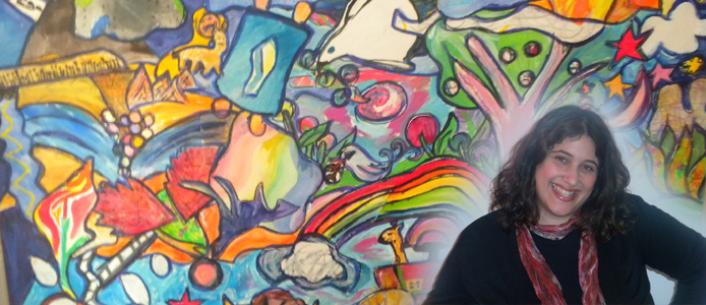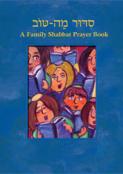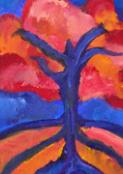- Home
- Play & Learn Home
- Online Enrichment
- Experience Modern Israel
- Israel It's Complicated
- Jewish and Me
- Jewish Holidays Jewish Values
- Jewish Values in Genesis and Jewish Values in Exodus
- Min Ha’aretz
- Our Place in the Universe
- Simply Seder
- The Prophets: Speaking Out for Justice
- Making T'filah Meaningful
- Make, Create, Celebrate
- Yom Haatzmaut Resources
- Hebrew Apps
- About The OLC
- What is the OLC?
- Introduction
- Get Started
- Resources
- OLC Content
- Parent Materials
- See My OLC Classes
- Store
Creative Jewish Educators Series: An Interview with Artist Julie Wohl
Written by Behrman House Staff, 20 of August, 2013
Julie Wohl is a Jewish educator as well as a professional artist. She is the education director at Congregation Brit Shalom in State College, PA, as well as the creator of Jewish Learning Thru Art, a traveling creative arts beit midrash.
“In our work at Jewish Learning Thru Art we offer communities and educators opportunities to engage with meaningful Jewish learning and art creation. We offer teacher training workshops that encourage educators to bring the arts into their own classrooms, and we offer community programs in which participants learn and create art together.”
Julie is the co-creator and illustrator of Siddur Mah Tov and the illustrator of Simply Seder, both published by Behrman House. She is a mixed media artist who parents, teaches and creates in Central Pennsylvania.
You can find out more about Julie’s work at: www.jewishlearningthruart.com and www.juliewohlfineartandjudaica.com
What prompted you to build a link between your life as an artist and your work as a Jewish educator?
I’ve always created art alongside whatever else I was doing. While in the Davidson School at the Jewish Theological Seminary I was looking for ways to blend my own creative pursuits with the content that I was learning. I was creating art in response to my learning, and eventually I started an informal group with a few other artists/Jewish educators. We would meet at our various apartments and create art, learn and socialize together. Only much later did I realize that what we were doing was helping me learn and reflect in such a deep way that I wanted to share that process with my students. I would bring art projects into my classrooms, and then when I started as a school director in New Jersey, I found ways to bring the arts into our whole school program. The key for me was realizing that the process of creating art was a powerful tool for deepening the connection to the learning. The arts were important, but for me as a Jewish educator, the Jewish content was even more important. The arts programming became such a highlight of the school that I was asked to share with other schools and educators. When I ended up moving and found myself with more time on my hands, it was a natural thing to start Jewish Learning thru Art as a way to continue building upon this niche.
Why are the arts important in Jewish education? Why are the arts important in Judaism?
The arts are incredibly important in Jewish education because they allow learners to create their own meaning—they allow the learner to deepen their connection to that which they are supposed to be learning. They are inherently personal, and require the creator to think and reflect in a non-traditional, non-verbal way.
The arts have always been important in Judaism. All cultures have a need for creation, and Judaism is no different. We have however, had a few obstacles to overcome. Most notably, the second commandment contains a prohibition against the creation of any image that could be mistaken or used for idol worship. Over time, this prohibition generalized into a prohibition against creating any recognizable form. However, as early as the 9th century, Jewish artists found a way around this prohibition. The creation of Hebrew micrography, creating images out of holy words, was a uniquely Jewish response to this prohibition. Responsa literature (letters to and from Rabbis with questions about how to solve problems from a Jewish law perspective) from the medieval period indicate that Jews everywhere were creating images and using art in holy spaces. And, of course, today, we use the concept of hiddur mitzvah, beautifying the mitzvah, to create beautiful Judaica and Jewish art. Our ritual objects, Torah dressings, paintings on synagogue walls, beautiful tallitot, and even non-religious art created by Jewish artists fill our world. I believe all of these make up what can be called “Jewish Art”.
How can teachers with no artistic skills or training bring the arts into Jewish education?
The techniques that I share with teachers are very simple and do not require artistic skill or training so much as an open mind and perhaps a certain degree of fearlessness. It can be scary to try new things or to bring something into the classroom that we ourselves are not comfortable with. However, our students need a wide variety of experiences to inform their learning. Simple techniques and materials are best for teachers without a great comfort level with art. However, amazing things can be accomplished with nothing more than some watercolors, oil pastels, construction paper and glue. One very easy technique that I use in my work all the time is what I call watercolor resist. In it, I give students good quality paper, oil pastels and watercolor paint. After teaching my lesson, I ask students to represent what they have learned, or to answer a particular question with this method:
Draw the main part of your image on paper using light colored oil pastels—whites, yellows, oranges, pinks, light blues. The colors should be light, but students should use some pressure when drawing—the firmer/stronger the line, the better the final result will be.
When you have finished your drawing, paint over it with darker colored watercolors (dark blues, purples, reds). The oil pastel will resist the watercolor paint so that the paint will only show up in the spaces in between. The result is very cool and always a surprise!
I also remind teachers that they do not need to be the ones creating the art, their students do. So, even if they feel they can barely draw a stick figure, they can still present the project to their students without fear—they do not need to draw at all, and their students will surely surprise them!
How do you engage unwilling participants, students who aren’t interested in art, or students who doubt their artistic abilities?
This is less of a problem than you might think. I always reassure my students (including the teachers that I train!) that this is not about creating a beautiful work of art. This is about finding a new way to learn and express our ideas. Children are generally hard wired to do the projects that we ask of them. When presented with a new way of doing art (not simply drawing with markers or crayon on paper), they generally engage without much difficulty. I actually find that when I am working with a multi-generational group, the children will get to work right away, but the adults, given the same exact instructions, have more follow up questions and are much more worried about “getting it right”.
One problem I do face is when a student does not spend time planning and creates a messy project quickly. While I do not care if the end result is technically beautiful (and I NEVER add my own hand to their work to help them “fix” it), it is important to me that they take it seriously and try their best. I often will ask students to create a draft version before going on to their final. I catch a lot of “quick” or thoughtless work that way, and will push them to think further, add more, or work harder on their final. I am not afraid to make specific requirements, like your work must include these three elements and the page must be completely covered. I’ll also ask them how their work specifically relates to the question. Pat or clichéd answers are not accepted. I want them to really think. I am not afraid to (kindly) ask a student to try again, or to do more. When they see that I take their work seriously and will not accept just anything, they tend to work harder.
With reduced class hours and less time to devote to “specials,” how can educators still use the arts in their curriculum?
The type of art that I am talking about does not exist outside the curriculum. Rather, it is a powerful tool for enhancing and enriching the existing curriculum. Though there may be a time and place for creating challah covers or candle sticks, this is not what I am talking about here. What I am talking about is learning a Torah story and creating a visual midrash about the relationship between the characters, or imaging the perspective of a silent character, or visualizing a scene (ie: determining what the angels in Jacob’s dream looked like, and where they were in relation to him and the ladder).
In this way, I believe that with reduced class hours and less time to devote to “specials” this type of work in classrooms is even more crucial.
In what ways can the arts be used in project-based learning?
When done in a well-planned and thoughtful way, this type of learning is the epitome of project based learning. These arts based lessons require deep thinking, problem solving, creative response and cooperative learning. They require creating multiple drafts, and they result in something deeply personal for each student. Additionally, the arts can be a piece of any project based learning experience. They can be utilized in creating final presentations, models, redesigns, and explorations of stories, values, traditions or other Jewish themes.





